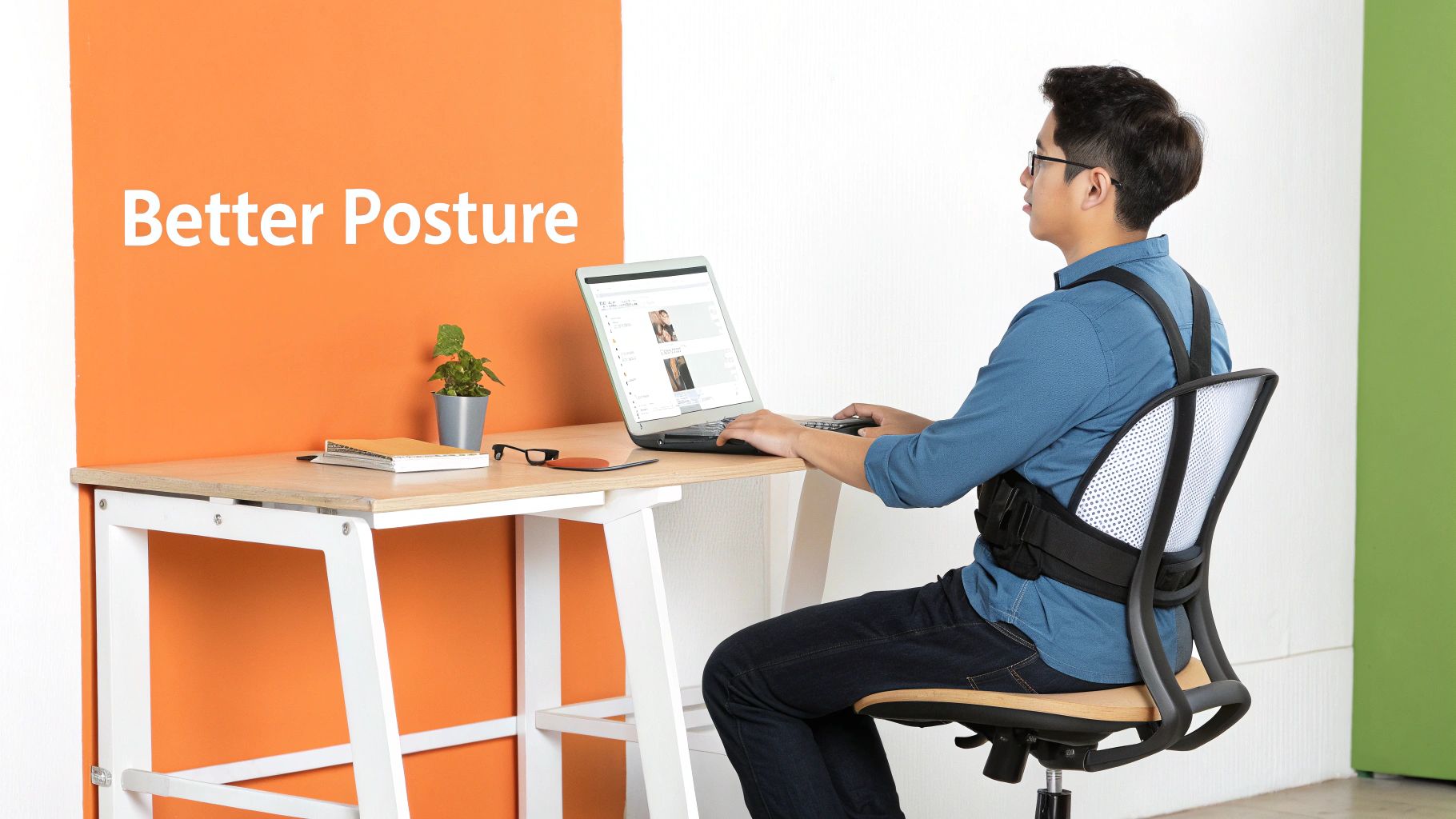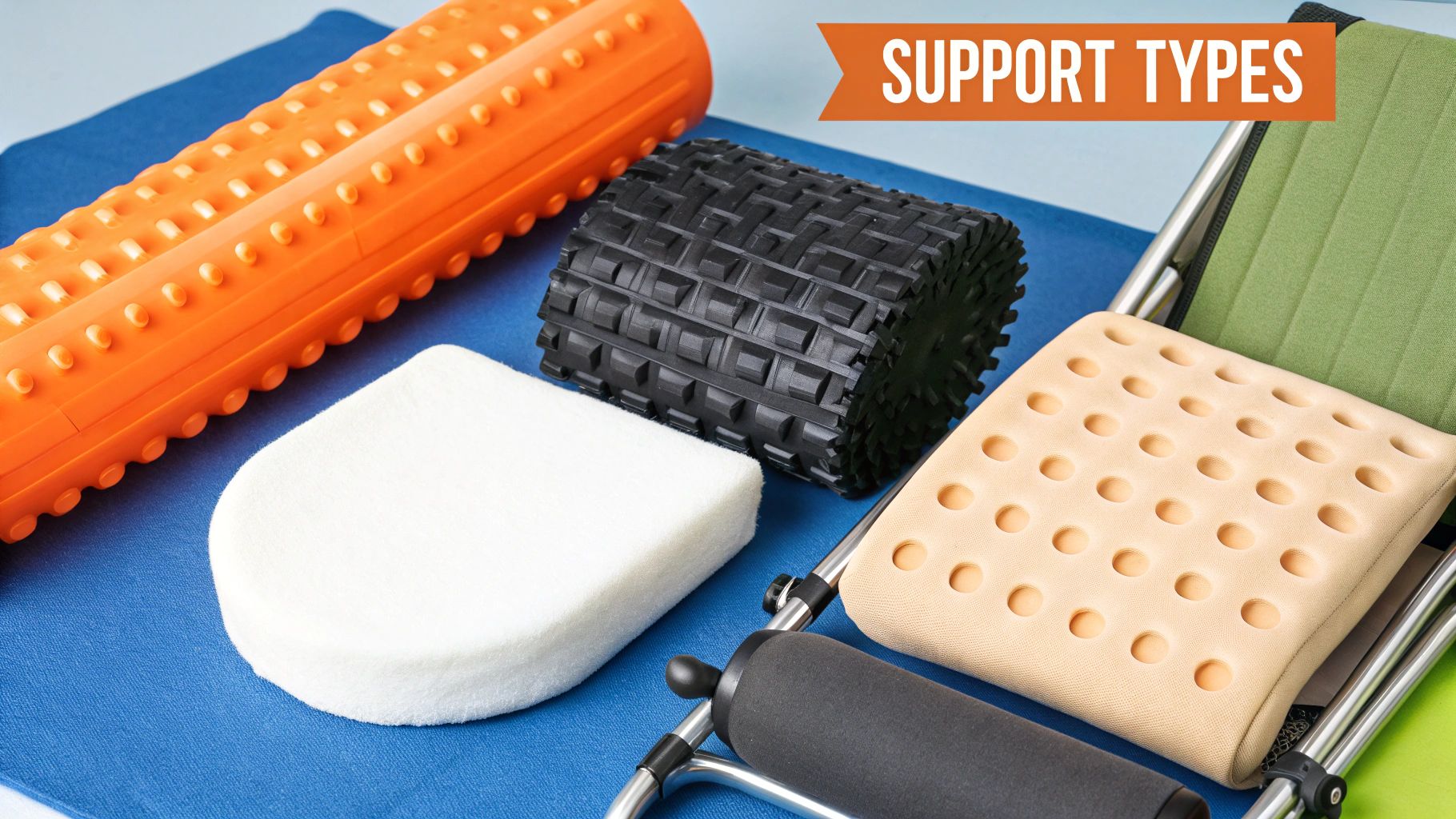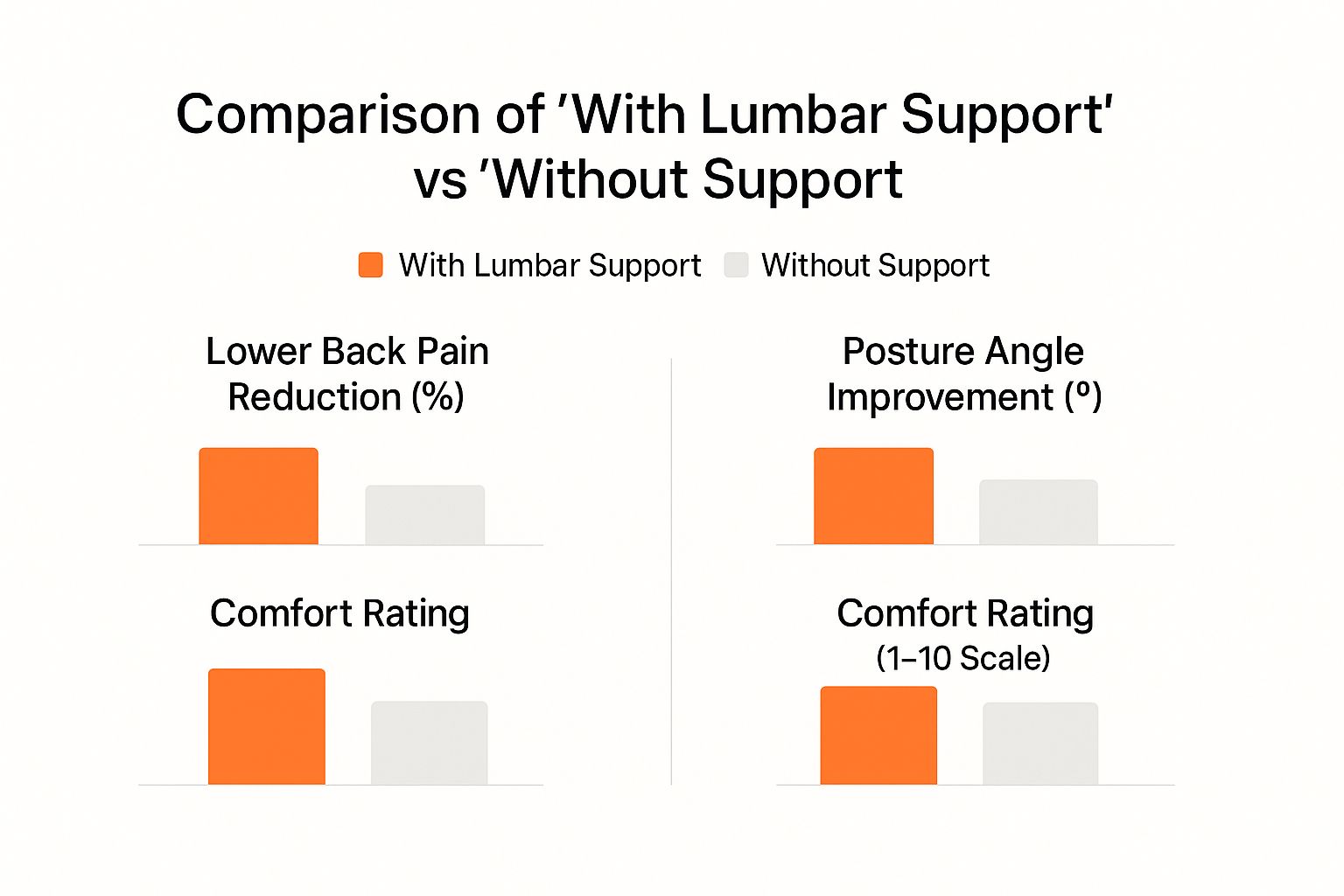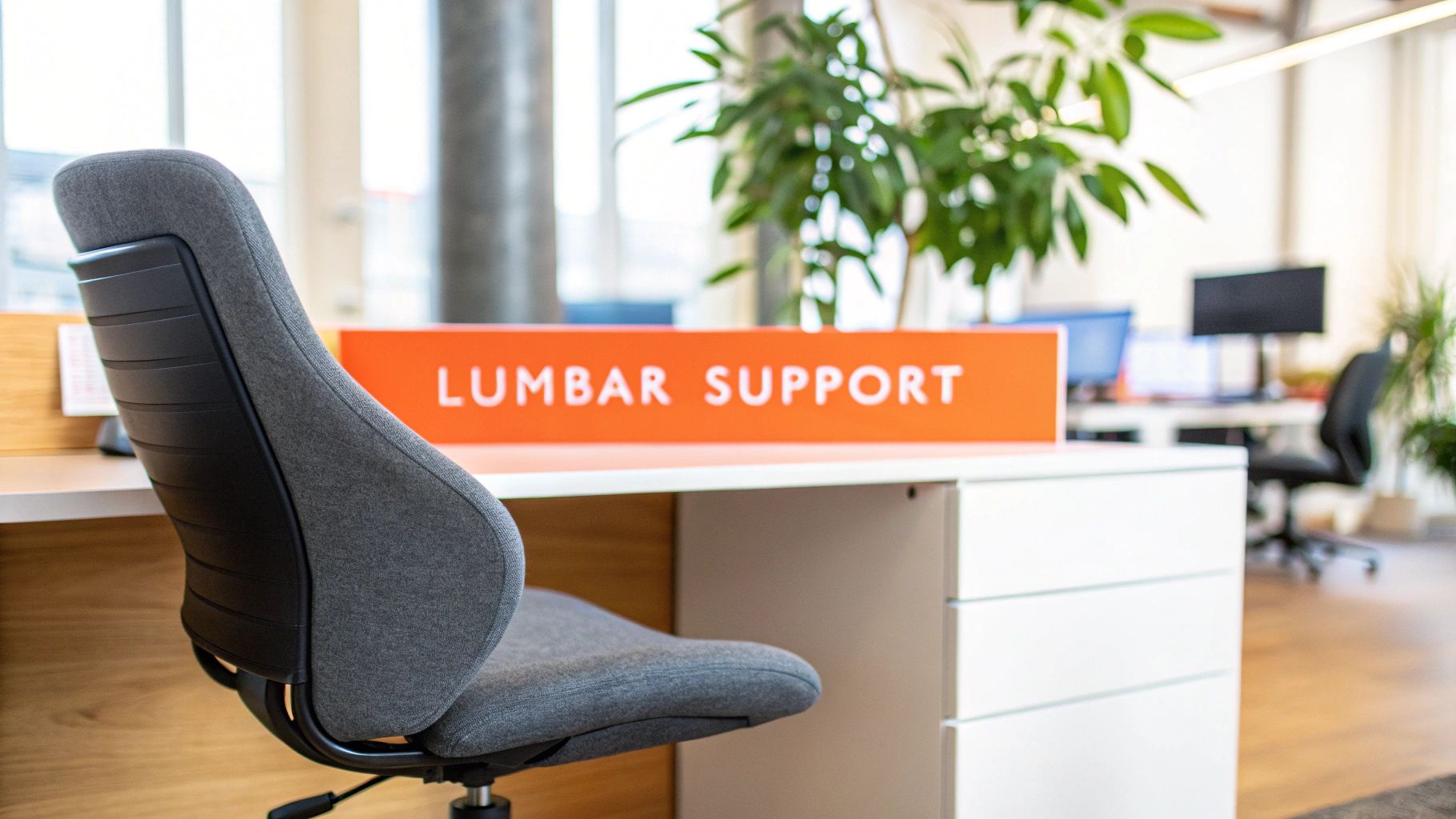At its heart, lumbar support is simply anything that helps you maintain the natural inward curve of your lower back. It works by filling that gap that often forms between your spine and the back of your chair, stopping you from slouching and helping keep your posture in check.
Think of it as a gentle, constant nudge for your back, reminding it to hold its healthy 'S' shape.
What Is Lumbar Support? A Simple Analogy

Picture your spine as a tent pole. For that tent to stand tall and stable, the pole needs to be assembled just right, with the correct tension. Your lower back—the lumbar region—has a natural, gentle inward curve that's vital for keeping this "pole" properly aligned and balanced.
When you sit down, especially in a chair that offers no real support, gravity and fatigue start to take over. You begin to slump. This common habit flattens that crucial curve in your lower back, a bit like a section of the tent pole bending the wrong way. The result? Unnecessary strain on your muscles, ligaments, and the discs in your spine.
The Problem With Modern Life
The real issue is that so much of modern life has us sitting for long stretches—at our desks, in the car, or relaxing on the couch. This constant slumping can eventually lead to chronic discomfort, muscle fatigue, and persistent back pain.
The scale of this is huge. In fact, research shows that almost 80% of Australians will deal with lower back pain at some point in their lives, making it a leading reason for missing work. This is why clinically proven solutions like ergonomic cushions and supportive chairs are so important; they reduce lumbar strain by helping you maintain the spine's natural curve. You can dive deeper into the research findings and the lumbar support market.
How Lumbar Support Provides the Solution
This is exactly where lumbar support steps in. It acts as a purpose-built cushion, designed to fill the space between your lower back and your chair. By providing firm, consistent pressure, it physically stops your lumbar curve from flattening out.
To really understand its role, let's break down its key functions.
Key Functions of Lumbar Support
Essentially, by keeping your spine in its correct shape, lumbar support becomes a powerful tool in preventing back pain before it starts.
By encouraging your spine to hold its correct ‘S’ shape, lumbar support is the first line of defence against back pain and postural strain. It's not just about comfort; it's about maintaining your body's natural structure.
This principle is fundamental to the design of premium ergonomic chairs, like the fantastic Pago chairs available on our website. These chairs often come with adjustable support, letting you fine-tune the height and firmness for a perfect, personalised fit—a feature you'll also find when you browse the Pago range at Officeworks.
Why Proper Lumbar Support Is a Game-Changer

It’s one thing to know what lumbar support is, but it’s another thing entirely to understand the difference it makes in your day-to-day life. This isn't just about dodging the occasional backache; it's about fundamentally changing how you work, focus, and feel.
Think about that classic 3 p.m. slump. We often blame it on a long day or a big lunch, but a lot of that fatigue is actually physical. After hours of sitting, your body starts to slouch, and your muscles work overtime trying to hold everything together. That constant effort is exhausting.
It’s the same story for anyone sitting for long stretches, from long-haul drivers to gamers. An unsupported lower back creates a nagging, distracting pain that pulls your attention away from what you’re doing. The result is always the same: less focus, flagging energy, and a growing discomfort that tanks your performance.
From Discomfort to Productivity
This is where the right kind of support really shines. When your chair or cushion properly props up your lumbar spine, you’re not just treating a symptom—you’re fixing the root cause of postural strain. The flow-on effects are huge.
- Sustained Energy: With your spine correctly aligned, your back muscles can finally relax. You stop wasting energy fighting gravity all day, which leaves you feeling more alert and engaged right through to knock-off time.
- Sharper Focus: Let's be honest, constant, low-grade pain is incredibly distracting. By getting rid of it, lumbar support frees up your mental bandwidth so you can pour all your concentration into your work.
- Reduced Back Pain: Of course, the most direct benefit is simple relief. Proper, consistent support helps prevent those daily aches from turning into long-term, chronic problems. To learn more, check out our guide on finding the best office chair for back pain.
Lumbar support isn't just a comfort feature; it's a productivity tool. By addressing the physical cause of strain, it helps reclaim the energy and focus that poor posture silently steals from you every day.
Choosing a chair with quality lumbar support isn’t just buying a piece of furniture. It’s a genuine investment in your long-term health and your ability to be effective every single day. A great example is a Pago chair available on our website or through Officeworks.
The Science of How Lumbar Support Works

To really get how lumbar support works, it helps to picture what's happening in your back when you sit. Think about that all-too-familiar slump over your desk. When you slouch, the natural inward curve of your lower back—your lumbar spine—flattens out or even pushes outward. This small shift puts a huge amount of strain on your spinal discs and the surrounding muscles trying to keep you upright.
This is where a good chair comes in. Lumbar support acts as a gentle but firm guide, pushing against your lower back just enough to stop you from collapsing into that unhealthy 'C' shape. Instead, it encourages your spine to hold its natural 'S' curve.
It’s a simple concept, but it triggers a positive domino effect all the way up your back. When the base of your spine is properly supported, your mid-back (thoracic) and neck (cervical) fall into better alignment. This helps pull your shoulders back and keeps your head in a much healthier position. If you're curious about the bigger picture, you can learn more about how to improve your posture in our detailed guide.
The Biological Benefits of Better Alignment
Holding this correct alignment isn't just about feeling more comfortable in the moment; it brings real, tangible benefits to your body. By preventing slouching, lumbar support directly eases the constant tension in your back muscles.
Suddenly, those muscles aren't fighting a losing battle against gravity all day, which means less fatigue and fewer of those nagging, chronic aches.
By maintaining spinal alignment, lumbar support reduces muscle tension, promotes better blood flow, and can help prevent nerve compression that leads to conditions like sciatica. It's a simple intervention with profound effects on your body's structural health.
This support also improves blood flow to the tissues in your lower back, bringing them the oxygen and nutrients they need to stay healthy. On top of that, it helps prevent the compression of nerves in your lumbar region—a common culprit behind sciatica and that awful pain that can shoot down your legs.
The growing awareness of these benefits is clear. In Australia, the market for orthopaedic supports, which includes lumbar support, was valued at around US$123.6 million and is expected to climb to US$188.2 million by 2030. This shows a significant shift towards making back health a priority.
Finding the Right Type of Lumbar Support
Everyone's back is different, so it makes sense that finding the right lumbar support is a very personal journey. What feels like a dream for your colleague might not do much for you. The key is to understand the different options out there—from supports built right into your chair to cushions you can take anywhere—and figure out which one fits your life and your back.
The Different Kinds of Lumbar Support
The best choice for all-day comfort, especially if you work at a desk, is built-in, adjustable lumbar support. You'll typically find this feature in good-quality ergonomic office chairs. It lets you tweak the height and depth of the support, so you can position it perfectly in the curve of your lower back. This kind of custom fit provides steady, targeted relief right where you need it, all day long.
What if you're not always at your desk? For those who are on the go or just need a boost for a less-than-ideal chair, portable options are a great shout.
- Memory foam pillows are fantastic. They’re great for adding support to your car seat or that stiff dining chair you’re temporarily using as an office chair. They shape themselves to your back, though you can't really adjust the pressure.
- Fixed cushions are a simple and affordable way to make a basic chair a bit more back-friendly. They offer a one-size-fits-most solution, which is better than nothing!
Matching the Support to Your Needs
To help you decide, let's break down the most common types of lumbar support and see where each one shines.
Comparing Lumbar Support Options
This table compares different lumbar support types to help you choose the best one for your needs.
As you can see, if you spend most of your day sitting, investing in a chair with an integrated, adjustable system really is the way to go. Chairs like those in the versatile Pago range available on our website are a perfect example. Their ability to adapt to your specific shape makes them a smart long-term investment in your spinal health. You can also pop into a store to see the Pago chairs at Officeworks and feel the difference for yourself.
The right support doesn't just feel good; it makes a measurable difference. Just look at the data below.

It’s pretty clear, isn't it? The improvements in pain reduction, posture, and overall comfort are significant when you compare sitting with proper support versus without it. It just goes to show how vital good support is for your well-being.
If there's one feature to prioritise for daily, long-term use, it's adjustability. The power to fine-tune the support to your unique body is what turns temporary relief into a lasting habit of good posture.
Ultimately, the best choice really does come down to your daily routine, your budget, and what feels right for you. But if you keep adjustability at the top of your list, you’ll be on the right track to a healthier, happier back.
How to Position Your Lumbar Support Correctly
Having a chair with great lumbar support is one thing, but getting it in just the right spot is what truly makes the difference. If it's not positioned correctly, you simply won't get the full benefit. The good news is, it’s a quick adjustment that can totally change how you feel at your desk.
The main goal is simple: fill the natural inward curve of your lower back.
First things first, sit all the way back in your chair. I mean all the way back, so your hips and bottom are right up against the backrest. This is the foundation for good posture. If you’re perched on the edge of your seat, no amount of fancy lumbar support will help align your spine.
With your feet flat on the floor and knees at about a 90-degree angle, feel for the small of your back. It’s that natural, gentle inward curve just above your belt line.
Fine-Tuning for a Perfect Fit
That little curve is your target. This is exactly where the lumbar support should fit.
If you have an adjustable chair, like a Pago chair available at Officeworks, you can slide the support up or down until it nestles perfectly into that space. It should feel supportive and firm, but not like something is aggressively pushing you forward.
The perfect placement feels natural. Your spine should feel gently guided into its 'S' curve, not forced. If it's uncomfortable, it’s not in the right spot.
Proper spinal alignment is incredibly important, not just for comfort but for long-term health. While ergonomic chairs are a key part of prevention, the consequences of poor spinal health are serious. To put it in perspective, the Australian market for lumbar spine cages—a surgical solution for severe back issues—is expected to grow by 5.6% each year from 2025 to 2030. You can read more about these healthcare projections.
Taking a moment to get this right ensures you’re getting the most out of your chair's design. For a more detailed walkthrough, check out our guide on setting up your office chair lumbar support.
Choosing the Right Ergonomic Chair for Your Long-Term Health
Now that you understand what lumbar support is and how to use it properly, let's talk about the most important step: finding a long-term solution. Being proactive with your spinal health is more than just a workplace trend; it's a critical investment in your daily well-being, comfort, and even your productivity.
While pillows and cushions can provide some temporary relief, they're often a band-aid solution. For the kind of consistent, adjustable foundation your body needs day in and day out, nothing beats a high-quality ergonomic chair.
This is where a purpose-built ergonomic chair really shines. It doesn’t just add a backrest; it integrates lumbar support into a complete system designed to align your entire body correctly.
More Than a Chair, It's a Commitment to Your Well-being
Pago chairs, for instance, are engineered with premium adjustable lumbar features. This allows you to fine-tune the support to perfectly match the unique curve of your spine—something a static cushion simply can't do.
This level of personalisation is the secret to preventing back pain before it starts and helps you stay focused and comfortable all day. Think of it less as a purchase and more as a genuine commitment to your long-term health.
Investing in a quality ergonomic chair is one of the most effective decisions you can make for your spinal health, turning the simple act of sitting into a restorative experience.
To make your next step an easy one, you can explore the full Pago ergonomic office chair collection right here on our website. You can also see the range in person at your local Officeworks. It’s time to take control of your comfort and discover just how much the right chair can transform your workday.
Got Questions About Lumbar Support? We've Got Answers.
Even after you've found what feels like the right lumbar support, a few questions can pop up. Let's tackle some of the most common ones so you can feel completely confident about your new, healthier way of sitting.
Is It Normal for Lumbar Support to Feel a Bit Uncomfortable at First?
Yes, a little bit of initial weirdness is completely normal. Think about it: if you've spent years slouching, your body has basically adapted to that incorrect posture. Introducing proper lumbar support is going to feel strange because it's actively retraining your back muscles to hold a healthier, natural curve.
The key here is that it should feel like gentle guidance, not a painful jab. If you're feeling any sharp pain, the support is probably too firm or positioned incorrectly. Give your body a few days to adjust, but if the pain doesn't go away, it's time to tweak your setup.
How Many Hours a Day Should I Use My Lumbar Support?
Honestly, you should be using it whenever you're sitting for a long stretch. The whole point of what is lumbar support is to offer continuous reinforcement for good posture, especially during those long days at your desk. Being consistent is what prevents the muscle fatigue that eventually leads to slouching.
Think of your lumbar support like wearing glasses. You wear them whenever you need to see clearly. In the same way, you should use your support whenever you need to sit correctly to avoid back strain.
For a deeper dive, you might find our guide on common chair and lumbar support questions really helpful. At the end of the day, though, the best advice is always to listen to what your body is telling you.
At Pago, our focus is on creating real, long-term solutions for your well-being. Feel free to explore our ergonomic Pago chairs on our website or pop into Officeworks to see the collection in person and find your perfect fit.


